Observation of Abrupt Changes in the Sea Surface Layer of the Adriatic Sea
Abstract
1. Introduction
2. Materials and Methods
2.1. Data
2.2. Methods
2.2.1. Synoptic Field Analysis Methods
2.2.2. Sea Data Analysis Methods
3. Results
4. Discussion and Conclusions
Author Contributions
Funding
Institutional Review Board Statement
Informed Consent Statement
Acknowledgments
Conflicts of Interest
Appendix A
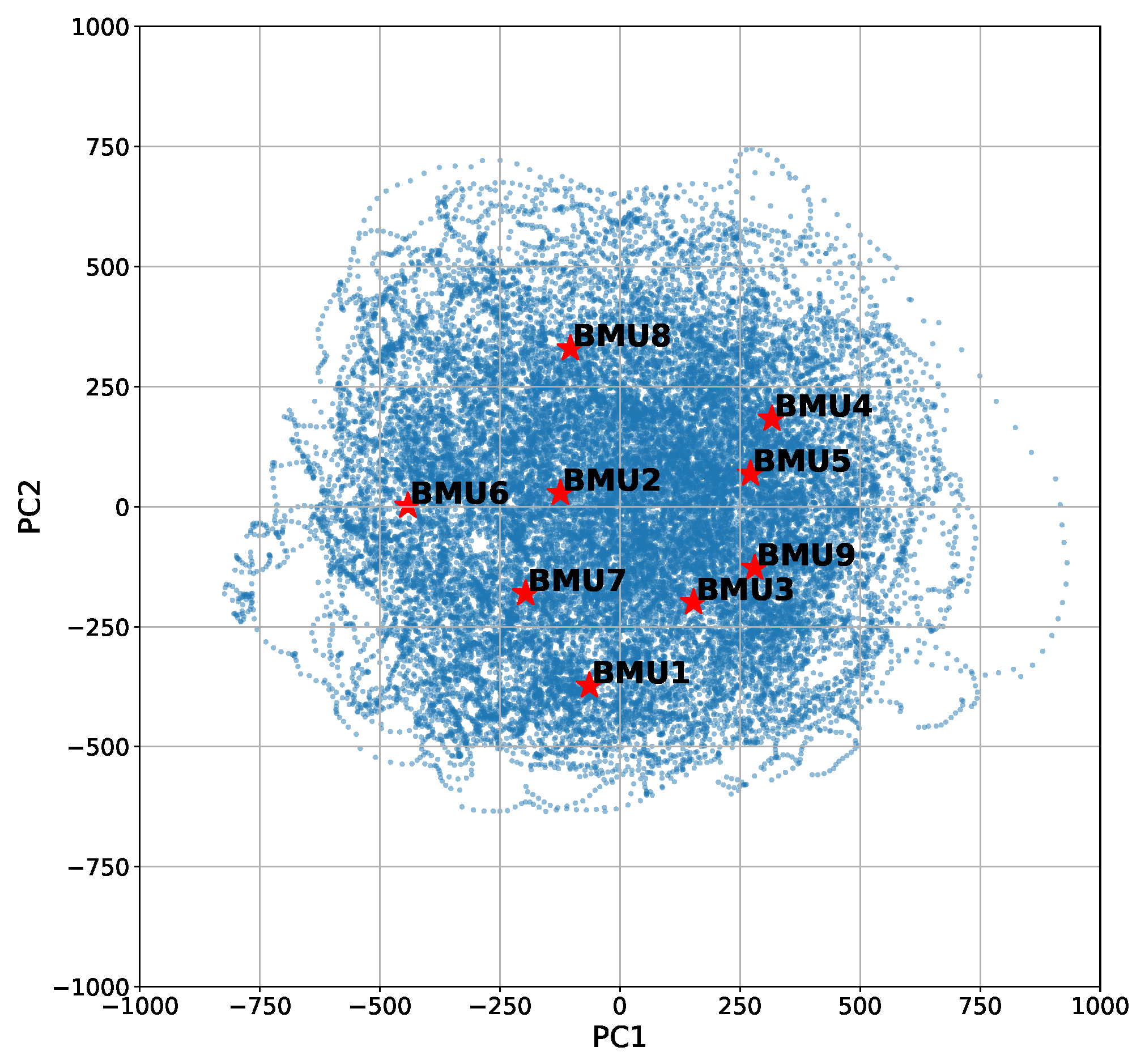
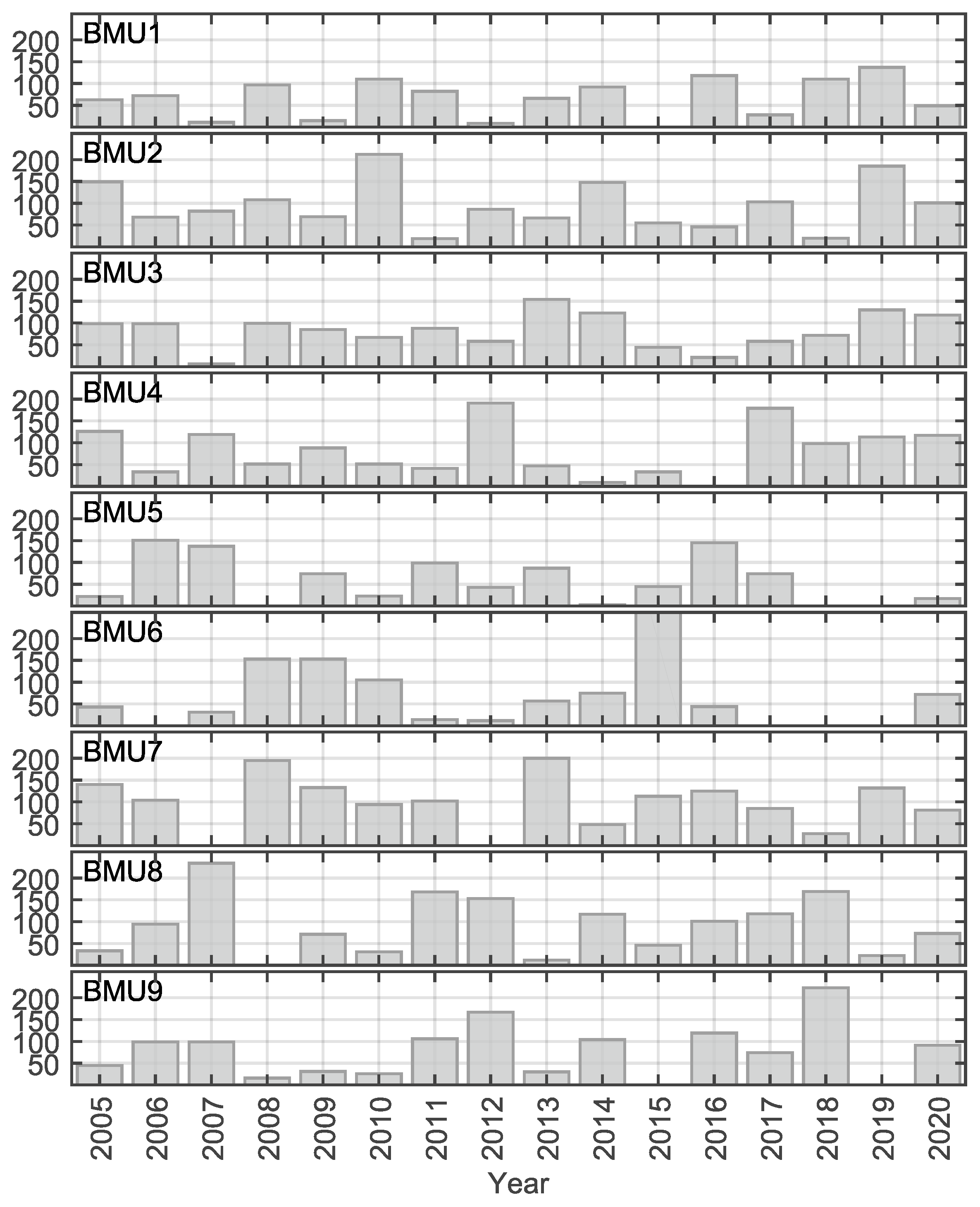
References
- Schlundt, M.; Brandt, P.; Dengler, M.; Hummels, R.; Fischer, T.; Bumke, K.; Krahmann, G.; Karstensen, J. Mixed layer heat and salinity budgets during the onset of the 2011 Atlantic cold tongue. J. Geophys. Res. Ocean. 2014, 119, 7882–7910. [Google Scholar] [CrossRef]
- Meyssignac, B.; Boyer, T.; Zhao, Z.; Hakuba, M.Z.; Landerer, F.W.; Stammer, D.; Köhl, A.; Kato, S.; L’Ecuyer, T.; Ablain, M.; et al. Measuring Global Ocean Heat Content to Estimate the Earth Energy Imbalance. Front. Mar. Sci. 2019, 6, 432. [Google Scholar] [CrossRef]
- Li, G.; Cheng, L.; Zhu, J.; Trenberth, K.E.; Mann, M.E.; Abraham, J.P. Increasing ocean stratification over the past half-century. Nat. Clim. Chang. 2020, 10, 1116–1123. [Google Scholar] [CrossRef]
- Grbec, B.; Matić, F.; Beg Paklar, G.; Morović, M.; Popović, R.; Vilibić, I. Long-Term Trends, Variability and Extremes of In Situ Sea Surface Temperature Measured Along the Eastern Adriatic Coast and its Relationship to Hemispheric Processes. Pure Appl. Geophys. 2018, 175, 4031–4046. [Google Scholar] [CrossRef]
- Šolić, M.; Grbec, B.; Matić, F.; Šantić, D.; Šestanović, S.; Gladan, Ž.N.; Bojanić, N.; Ordulj, M.; Jozić, S.; Vrdoljak, A. Spatio-temporal reproducibility of the microbial food web structure associated with the change in temperature: Long-term observations in the Adriatic Sea. Prog. Oceanogr. 2018, 161, 87–101. [Google Scholar] [CrossRef]
- Šolić, M.; Šantić, D.; Šestanović, S.; Bojanić, N.; Grbec, B.; Jozić, S.; Vrdoljak, A.; Ordulj, M.; Matić, F.; Kušpilić, G.; et al. Impact of water column stability dynamics on the succession of plankton food web types in the offshore area of the Adriatic Sea. J. Sea Res. 2020, 158, 101860. [Google Scholar] [CrossRef]
- Mihanović, H.; Vilibić, I.; Šepić, J.; Matić, F.; Ljubešić, Z.; Mauri, E.; Gerin, R.; Notarstefano, G.; Poulain, P. Observation, Preconditioning and Recurrence of Exceptionally High Salinities in the Adriatic Sea. Front. Mar. Sci. 2021, 8, 672210. [Google Scholar] [CrossRef]
- Gačić, M.; Borzelli, G.L.E.; Civitarese, G.; Cardin, V.; Yari, S. Can internal processes sustain reversals of the ocean upper circulation? The Ionian Sea example. Geophys. Res. Lett. 2018, 37, L09608. [Google Scholar] [CrossRef]
- Mihanović, H.; Vilibić, I.; Dunić, N.; Šepić, J. Mapping of decadal middle Adriatic oceanographic variability and its relation to the BiOS regime. J. Geophys. Res. Ocean. 2015, 120, 5615–5630. [Google Scholar] [CrossRef]
- Batistić, M.; Viličić, D.; Kovačević, V.; Jasprica, N.; Garić, R.; Lavigne, H.; Carić, M. Occurrence of winter phytoplankton bloom in the open southern Adriatic: Relationship with hydroclimatic events in the Eastern Mediterranean. Cont. Shelf Res. 2019, 174, 12–25. [Google Scholar] [CrossRef]
- Menna, M.; Gačić, M.; Martellucci, R.; Notarstefano, G.; Fedele, G.; Mauri, E.; Gerin, R.; Poulain, P.-M. Climatic, Decadal, and Interannual Variability in the Upper Layer of the Mediterranean Sea Using Remotely Sensed and In-Situ Data. Remote Sens. 2022, 14, 1322. [Google Scholar] [CrossRef]
- Vilibić, I.; Zemunik, P.; Dunić, N.; Mihanović, H. Local and remote drivers of the observed thermohaline variability on the northern Adriatic shelf (Mediterranean Sea). Cont. Shelf Res. 2020, 199, 104110. [Google Scholar] [CrossRef]
- Civitarese, G.; Gačić, M.; Lipizer, M.; Eusebi Borzelli, G.L. On the impact of the Bimodal Oscillating System (BiOS) on the biogeochemistry and biology of the Adriatic and Ionian Seas (Eastern Mediterranean). Biogeosciences 2010, 7, 3987–3997. [Google Scholar] [CrossRef]
- Gačić, M.; Civitarese, G.; Kovačević, V.; Ursella, L.; Bensi, M.; Menna, M.; Cardin, V.; Poulain, P.M.; Cosoli, S.; Notarstefano, G.; et al. Extreme winter 2012 in the Adriatic: An example of climatic effect on the BiOS rhythm. Ocean Sci. 2014, 10, 513–522. [Google Scholar] [CrossRef]
- Lionello, P.; Bhend, P.; Buzzi, A.; Della-Marta, P.M.; Krichak, S.O.; Jansà, A.; Maheras, P.; Sanna, A.; Trigo, I.F.; Trigo, R. Chapter 6 Cyclones in the Mediterranean region: Climatology and effects on the environment. Dev. Earth Environ. Sci. 2006, 4, 325–372. [Google Scholar] [CrossRef]
- Ulbrich, U.; Lionello, P.; Belušić, D.; Jacobeit, J.; Knippertz, P.; Kuglitsch, F.G.; Leckebusch, G.C.; Luterbacher, J.; Maugeri, M.; Maheras, P.; et al. Climate of the mediterranean: Synoptic patterns, temperature, precipitation, winds, and their extremes. In The Climate of the Mediterranean Region, 1st ed.; Elsevier: Amsterdam, The Netherlands, 2012; pp. 301–346. [Google Scholar] [CrossRef]
- Horvath, K.; Lin, Y.L.; Ivančan-Picek, B. Classification of cyclone tracks over the Apennines and the Adriatic Sea. Mon. Weather Rev. 2008, 136, 2210–2227. [Google Scholar] [CrossRef]
- Klaić, Z.B.; Pasarić, Z.; Tudor, M. On the interplay between sea-land breezes and Etesian winds over the Adriatic. J. Mar. Syst. 2009, 78, 101–118. [Google Scholar] [CrossRef]
- Pandžić, K.; Likso, T. Eastern Adriatic typical wind field patterns and large-scale atmospheric conditions. Int. J. Climatol. 2005, 25, 81–98. [Google Scholar] [CrossRef]
- Pasarić, Z.; Belušić, D.; Klaić, Z.B. Orographic influences on the Adriatic Sirocco wind. Ann. Geophys. 2007, 25, 1263–1267. [Google Scholar] [CrossRef][Green Version]
- Grisogono, B.; Belušić, D. A review of recent advances in understanding the meso- and microscale properties of the severe Bora wind. Tellus A 2009, 61A, 1–16. [Google Scholar] [CrossRef]
- Belušić, A.; Prtenjak, M.T.; Güttler, I.; Ban, N.; Leutwyler, D.; Schär, C. Near-surface wind variability over the broader Adriatic region: Insights from an ensemble of regional climate models. Clim. Dyn. 2018, 50, 4455–4480. [Google Scholar] [CrossRef]
- Simmonds, E.J.; Maclennan, D.N. Fisheries Acoustics: Theory and Practice; Blackwell Publishing: Oxford, UK, 2005. [Google Scholar]
- Leonori, I.; Tičina, V.; Giannoulaki, M.; Hattab, T.; Inglesias, M.; Bonanno, A.; Costantini, I.; Canduci, G.; Machias, A.; Ventero, A.; et al. The history of hydroacoustic surveys on small pelagic fishes in the European Mediterranean Sea. Mediterr. Mar. Sci. 2021, 22, 751–768. [Google Scholar] [CrossRef]
- Hersbach, H.; Bell, B.; Berrisford, P.; Hirahara, S.; Horányi, A.; Muñoz-Sabater, J.; Nicolas, J.; Peubey, C.; Radu, R.; Schepers, D.; et al. The ERA5 global reanalysis. Q. J. R. Meteorol. Soc. 2020, 146, 1999–2049. [Google Scholar] [CrossRef]
- Hersbach, H.; Bell, B.; Berrisford, P.; Biavati, G.; Horányi, A.; Sabater, J.M.; Nicolas, J.; Peubey, C.; Radu, R.; Rozum, I.; et al. ERA5 Hourly Data on Pressure Levels from 1979 to Present. Copernicus Climate Change Service (C3S) Climate Data Store (CDS). 2020. Available online: https://rmets.onlinelibrary.wiley.com/doi/10.1002/qj.3803 (accessed on 15 March 2021).
- Hersbach, H.; Bell, B.; Berrisford, P.; Biavati, G.; Horányi, A.; Sabater, J.M.; Nicolas, J.; Peubey, C.; Radu, R.; Rozum, I.; et al. ERA5 Hourly Data on Single Levels from 1979 to Present. Copernicus Climate Change Service (C3S) Climate Data Store (CDS). 2021. Available online: https://rmets.onlinelibrary.wiley.com/doi/10.1002/qj.4174 (accessed on 15 March 2021).
- Kohonen, T. Self-organized formation of topologically correct feature maps. Biol. Cybern. 1982, 43, 59–69. [Google Scholar] [CrossRef]
- Gladan, Ž.N.; Matić, F.; Arapov, J.; Skejić, S.; Bužančić, M.; Bakrač, A.; Straka, M.; Dekneudt, Q.; Grbec, B.; Garber, R.; et al. The relationship between toxic phytoplankton species occurrence and environmental and meteorological factors along the Eastern Adriatic coast. Harmful Algae 2020, 92, 101745. [Google Scholar] [CrossRef] [PubMed]
- Grilli, F.; Accoroni, S.; Acri, F.; Aubry, F.B.; Bergami, C.; Cabrini, M.; Campanelli, A.; Giani, M.; Guicciardi, S.; Marini, M.; et al. Seasonal and Interannual Trends of Oceanographic Parameters over 40 Years in the Northern Adriatic Sea in Relation to Nutrient Loadings Using the EMODnet Chemistry Data Portal. Water 2020, 12, 2280. [Google Scholar] [CrossRef]
- Fritzke, B. A growing neural gas network learns topologies. Adv. Neural Inf. Process. Syst. 1995, 7, 625–632. [Google Scholar]
- Patel, R. To Compute Mixed Layer Depth Based on Subjective Method. MATLAB Central File Exchange. 2021. Available online: https://www.mathworks.com/matlabcentral/fileexchange/53370-to-compute-mixed-layer-depth-based-on-subjective-method (accessed on 20 January 2021).
- McDougall, T.J.; Barker, P.M. Getting started with TEOS-10 and the Gibbs Seawater (GSW) Oceanographic Toolbox. 2011; 28p, ISBN 978–0-646-55621-5. Available online: www.TEOS-10.org (accessed on 15 March 2021).
- Kara, A.B.; Rochford, P.A.; Hurlburt, H.E. An optimal definition for ocean mixed layer depth. J. Geophys. Res. 2000, 105, 16803–16821. [Google Scholar] [CrossRef]
- Levitus, S. Climatological Atlas of the World Ocean; Department of Commerce, National Oceanic and Atmospheric Administration: Washington, DC, USA, 1982. [Google Scholar]
- de Boyer Montégut, C.; Madec, G.; Fischer, A.S.; Lazar, A.; Iudicone, D. Mixed layer depth over the global ocean: An examination of profile data and a profile-based climatology. J. Geophys. Res. 2004, 109, C12003. [Google Scholar] [CrossRef]
- Meehl, G.A. A Calculation of Ocean Heat Storage and Effective Ocean Surface Layer Depths for the Northern Hemisphere. J. Phys. Oceanogr. 1984, 14, 1747–1761. [Google Scholar] [CrossRef]
- Simpson, J.H.; Bowers, D. Models of stratification and frontal movement in shelf seas. Deep. Sea Res. 1981, A28, 727–738. [Google Scholar] [CrossRef]
- Rodionov, S. A Sequential Method of Detecting Abrupt Changes in the Correlation Coefficient and Its Application to Bering Sea Climate. Climate 2015, 3, 474–491. [Google Scholar] [CrossRef]
- Rodionov, S. A sequential algorithm for testing climate regime shifts. Geophys. Res. Lett. 2004, 31, L09204. [Google Scholar] [CrossRef]
- Rodionov, S. Use of prewhitening in climate regime shift detection. Geophys. Res. Lett. 2006, 33, L12707. [Google Scholar] [CrossRef]
- Regime Shift Detection Software. Available online: https://sites.google.com/view/regime-shift-test (accessed on 10 October 2021).
- Vilibić, I.; Mihanović, H.; Janeković, I.; Denamiel, C.; Poulain, P.M.; Orlić, M.; Dunić, N.; Dadić, V.; Pasarić, M.; Muslim, S.; et al. Wintertime dynamics in the coastal northeastern Adriatic Sea: The NAdEx 2015 experiment. Ocean Sci. 2018, 14, 237–258. [Google Scholar] [CrossRef]
- Vilibić, I.; Mihanović, H. Observing the bottom density current over a shelf using an Argo profiling float. Geophys. Res. Lett. 2013, 40, 910–915. [Google Scholar] [CrossRef]
- Vilibić, I.; Supić, N. Dense water generation on a shelf: The case of the Adriatic Sea. Ocean Dyn. 2005, 55, 403–415. [Google Scholar] [CrossRef]
- Mihanović, H.; Vilibić, I.; Carniel, S.; Tudor, M.; Russo, A.; Bergamasco, A.; Bubić, N.; Ljubešić, Z.; Viličić, D.; Boldrin, A. Exceptional dense water formation on the Adriatic shelf in the winter of 2012. Ocean Sci. 2013, 9, 561–572. [Google Scholar] [CrossRef]
- Mann, H.B. Nonparametric tests against trend. Econometrica 1945, 13, 245–259. [Google Scholar] [CrossRef]
- Kendall, M.G. Rank Correlation Methods; Oxford University Press: New York, NY, USA, 1975. [Google Scholar]
- Python Sklearn. Decomposition Package. Available online: https://scikit-learn.org/stable/index.html (accessed on 20 January 2021).
- Artegiani, A.; Paschini, E.; Russo, A.; Bregant, D.; Raicich, F.; Pinardi, N. The Adriatic Sea General Circulation. Part I: Air-Sea Interactions and Water Mass Structure. J. Phys. Oceanogr. 1997, 27, 1492–1514. [Google Scholar] [CrossRef]
- Denamiel, C.; Tojčić, I.; Vilibić, I. Balancing accuracy and efficiency of atmospheric models in the northern Adriatic during severe bora events. J. Geophys. Res. Atmos. 2021, 126, e2020JD033516. [Google Scholar] [CrossRef]
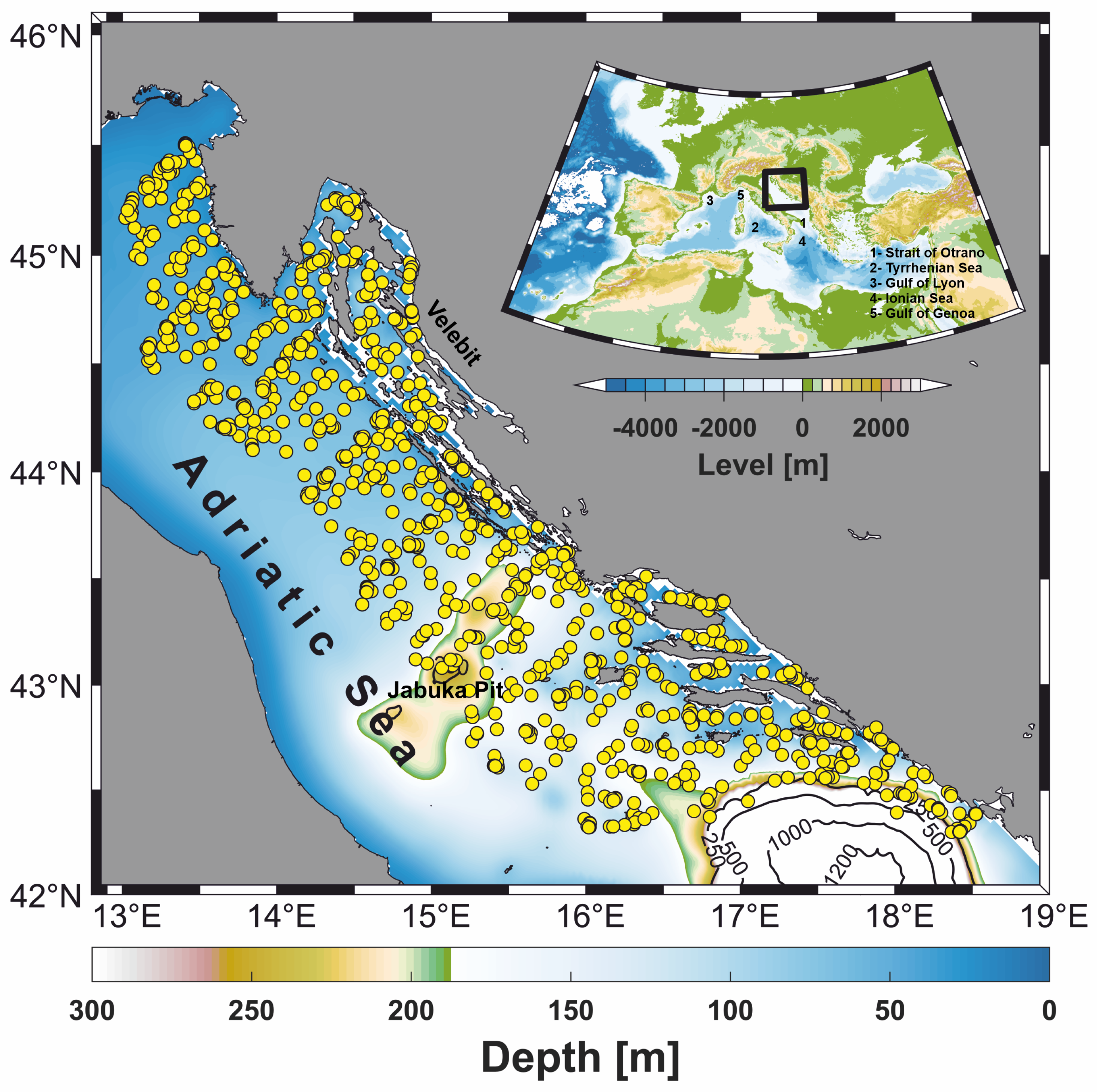
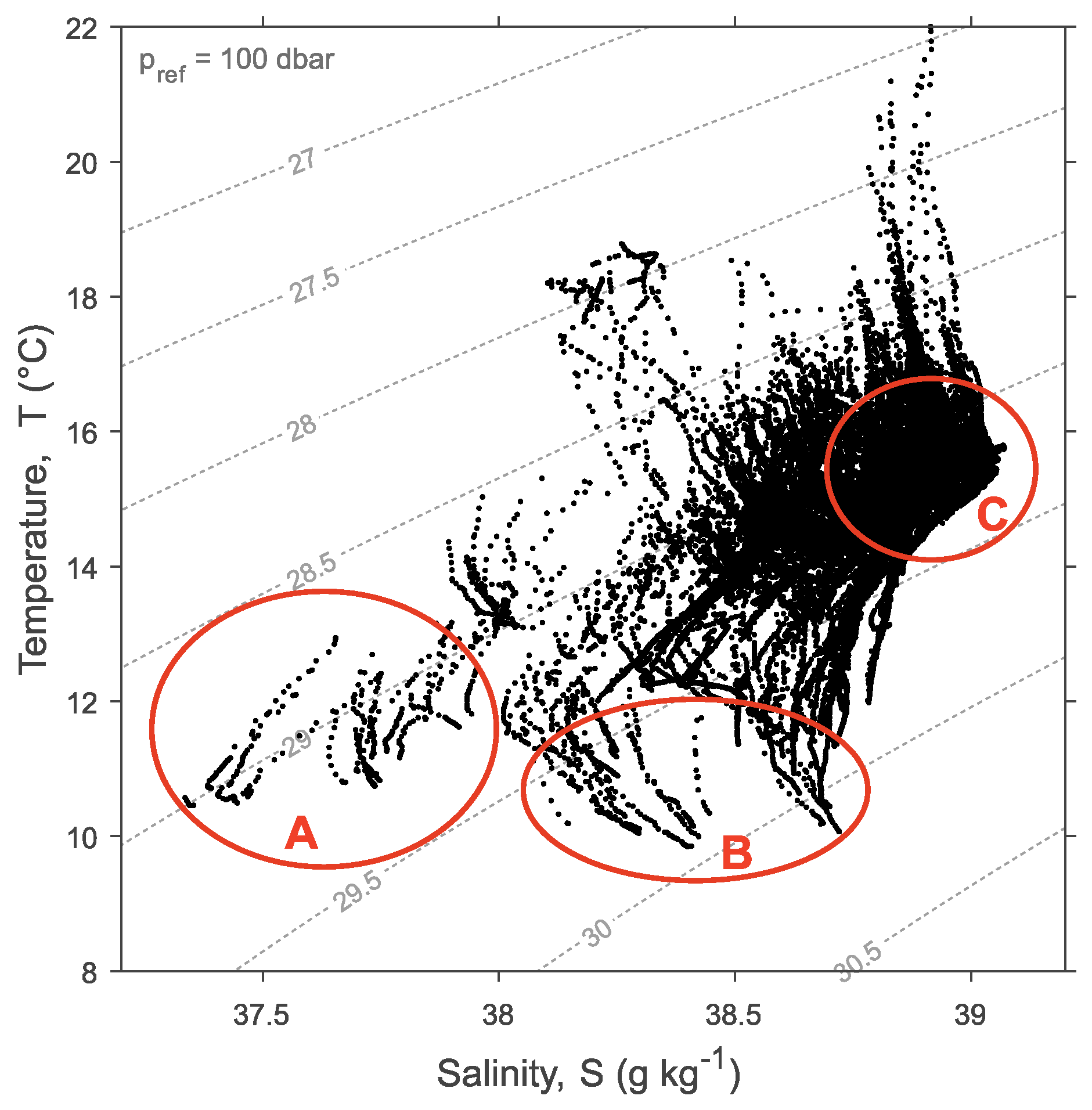
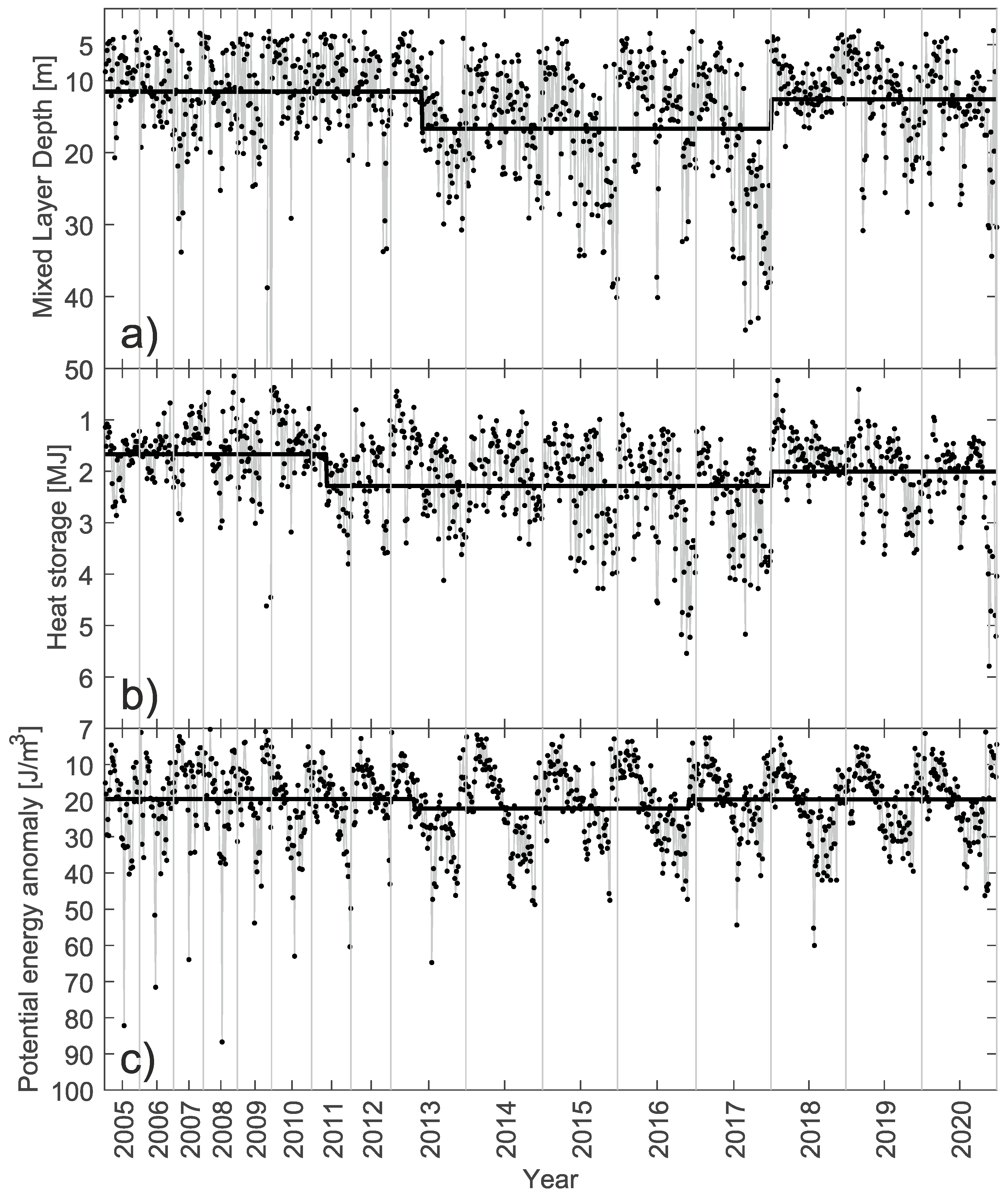
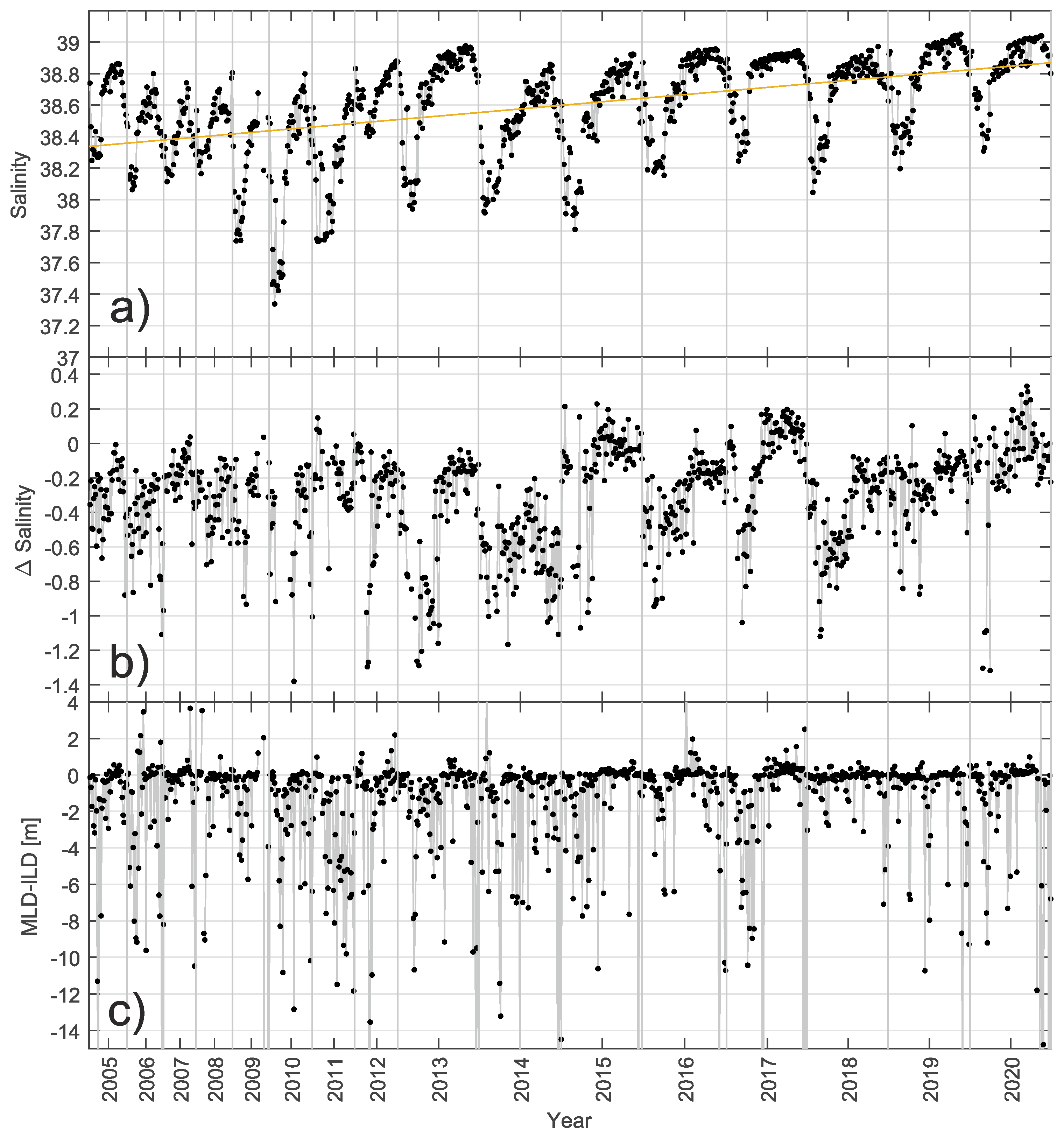
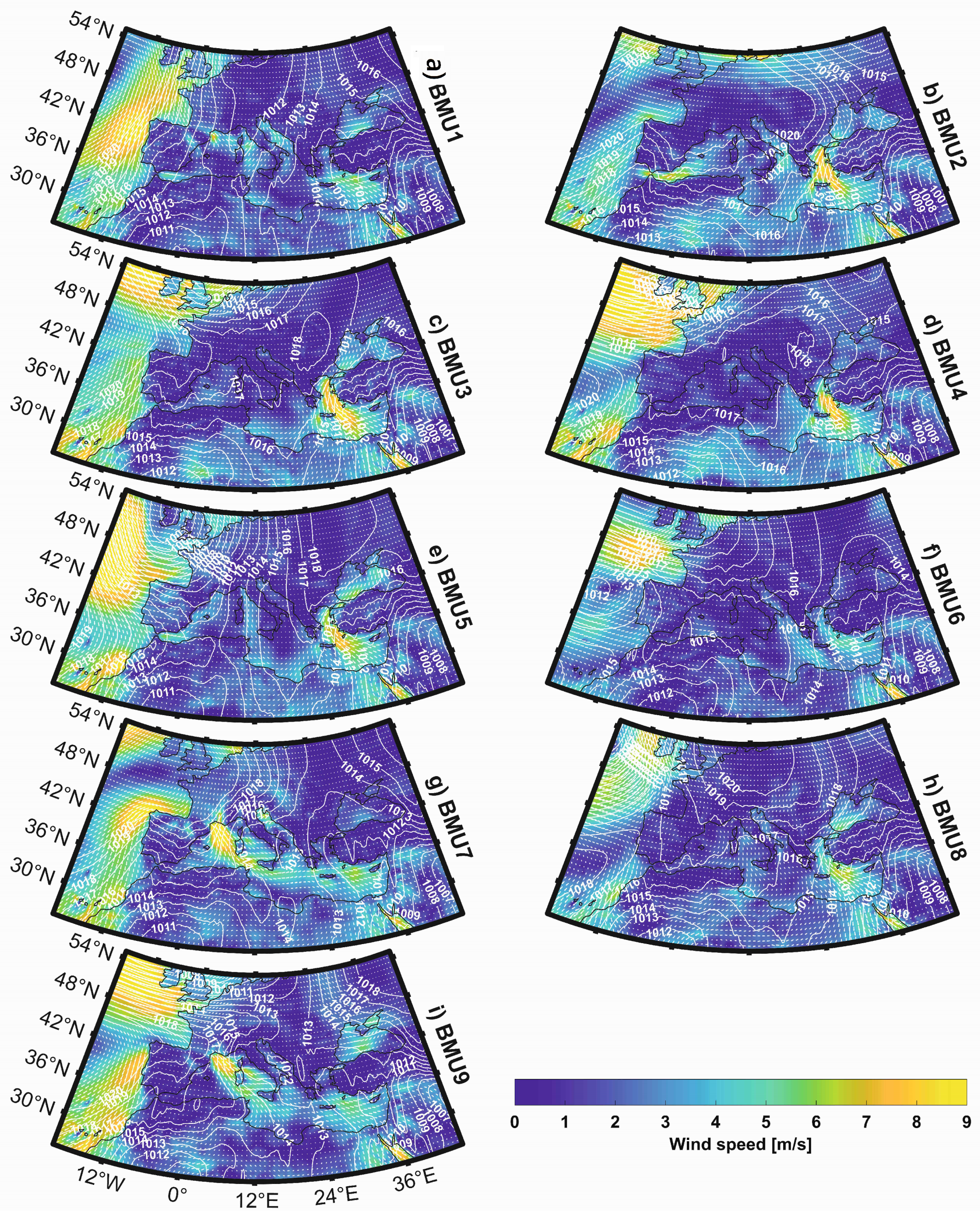
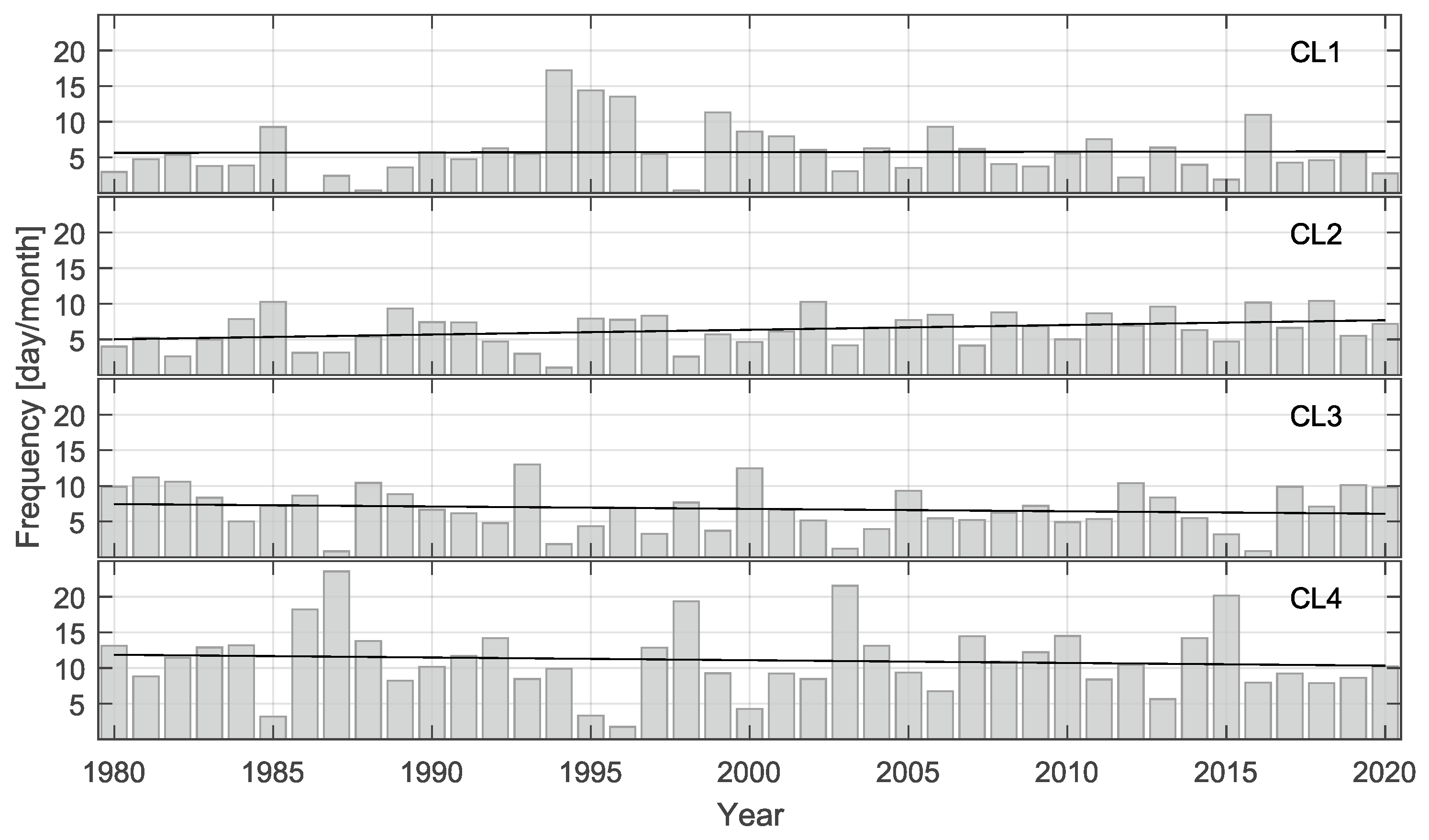
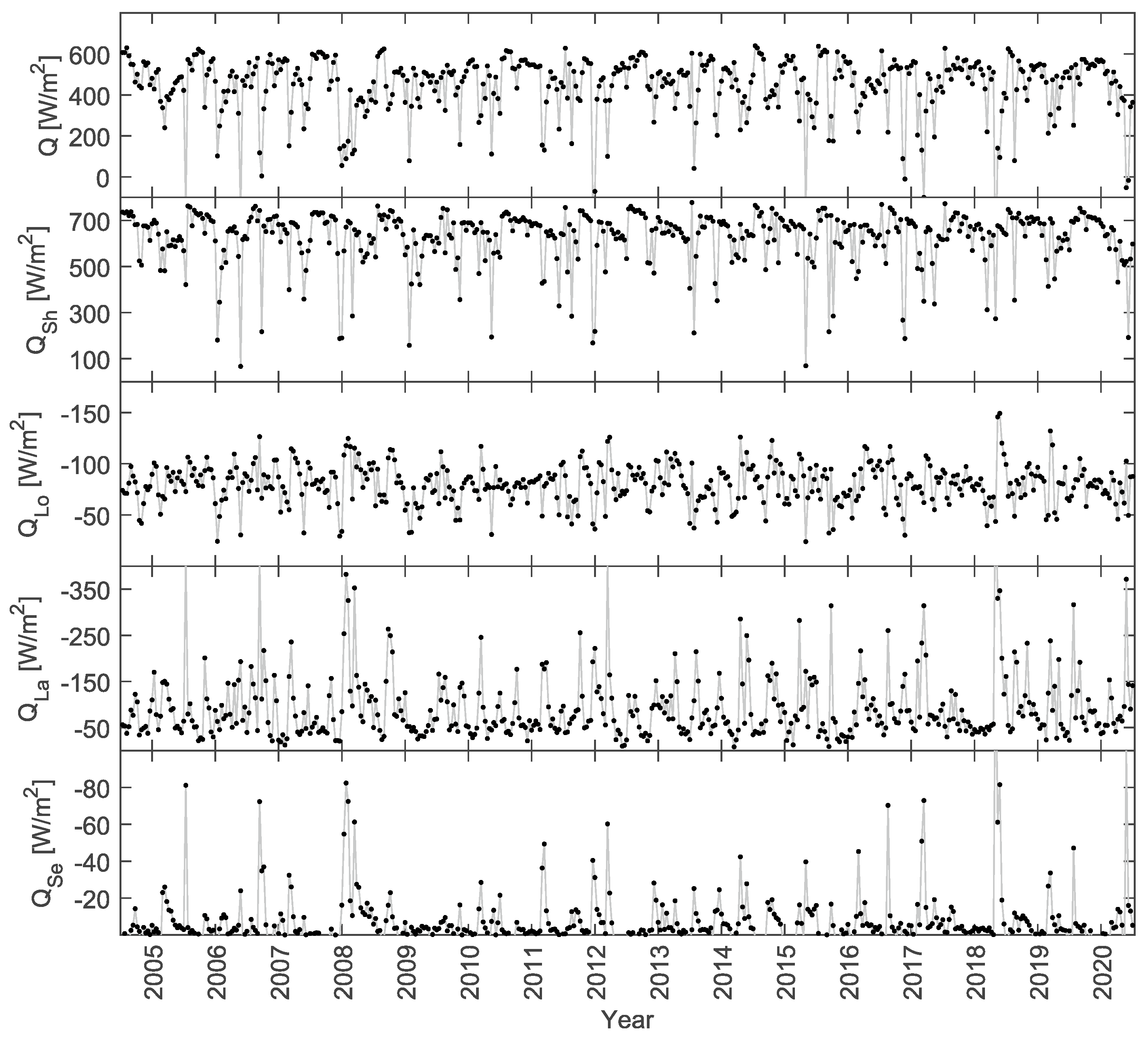
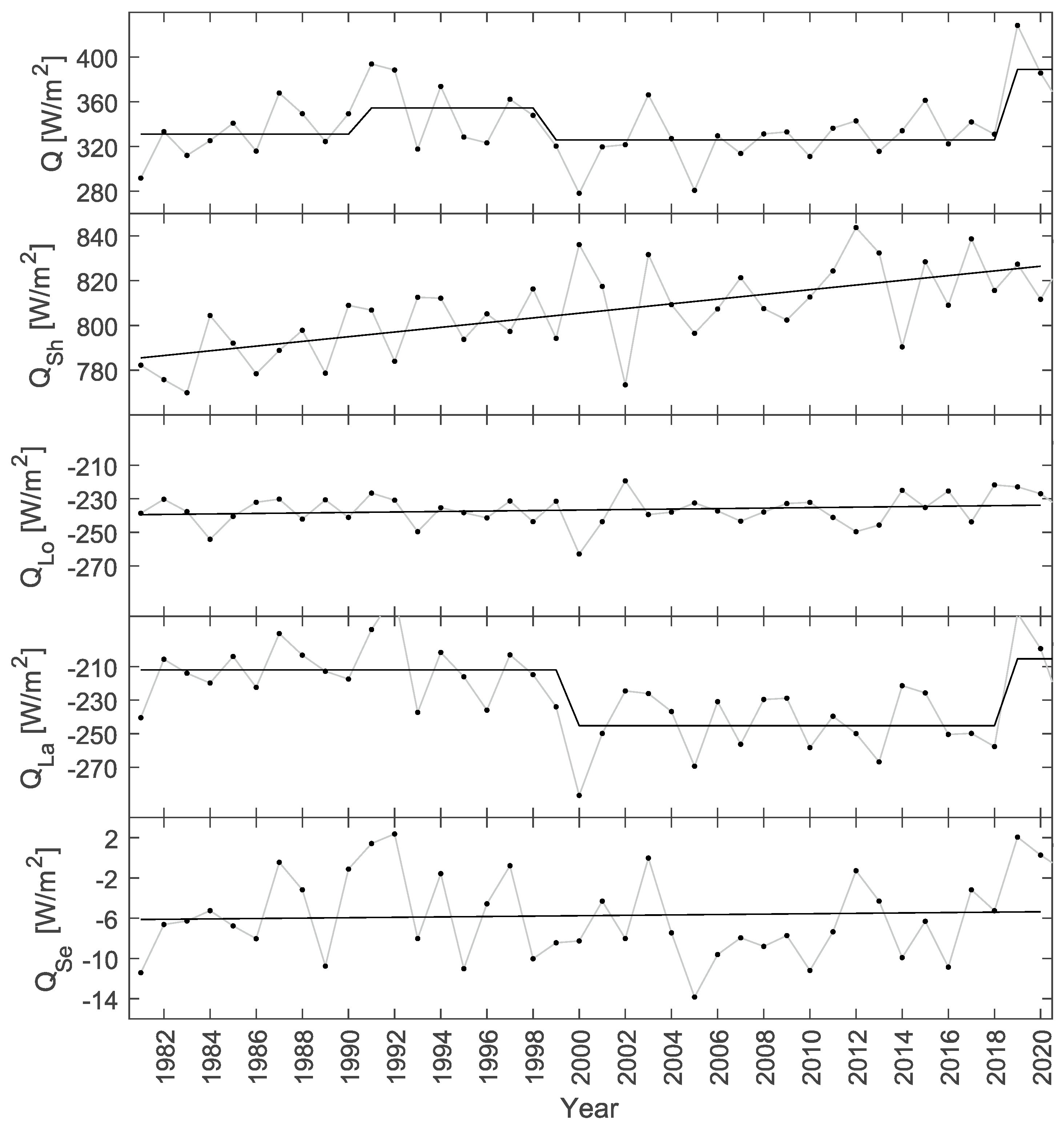
| Cruise | CTD | Latitude [N] | Longitude [E] | ||||
|---|---|---|---|---|---|---|---|
| Year | Start | End | Cast | Min | Max | Min | Max |
| 2005 | 20 August | 4 September | 43 | 42.306500 | 45.325667 | 13.252333 | 18.414000 |
| 2006 | 2 September | 18 September | 43 | 42.352000 | 45.324500 | 13.147667 | 18.460167 |
| 2007 | 31 August | 17 September | 35 | 42.349833 | 45.380667 | 13.327500 | 18.464167 |
| 2008 | 1 September | 18 September | 43 | 42.585000 | 45.318667 | 13.252000 | 18.119667 |
| 2009 | 21 September | 14 November | 43 | 42.342167 | 45.373333 | 13.235333 | 18.483500 |
| 2010 | 2 September | 18 September | 48 | 42.325983 | 45.336367 | 13.130117 | 18.451183 |
| 2011 | 5 September | 18 September | 49 | 43.101283 | 45.430483 | 13.078833 | 16.390667 |
| 2012 | 3 September | 18 September | 48 | 43.403000 | 45.473667 | 13.019833 | 16.390667 |
| 2013 | 3 September | 29 September | 88 | 42.299500 | 45.507333 | 13.066667 | 18.527000 |
| 2014 | 4 September | 30 September | 90 | 42.315900 | 45.510083 | 13.061350 | 18.403533 |
| 2015 | 4 September | 5 October | 88 | 42.305333 | 45.494167 | 13.061500 | 18.427667 |
| 2016 | 24 August | 21 September | 93 | 42.340380 | 45.467690 | 13.057620 | 18.518370 |
| 2017 | 30 August | 30 September | 89 | 42.299917 | 45.505083 | 13.059733 | 18.523283 |
| 2018 | 29 August | 23 September | 90 | 42.304167 | 45.504833 | 13.062333 | 18.523833 |
| 2019 | 28 August | 28 September | 91 | 42.300042 | 45.499512 | 13.048550 | 18.524533 |
| 2020 | 28 August | 5 October | 88 | 42.300905 | 45.498322 | 13.033302 | 18.524583 |
| BMU1 | BMU2 | BMU3 | BMU4 | BMU5 | BMU6 | BMU7 | BMU8 | BMU9 | |
|---|---|---|---|---|---|---|---|---|---|
| Q | 438.89 | 461.16 | 495.67 * | 437.48 | 416.54 | 418.13 | 440.80 | 426.88 | 473.61 ** |
| 627.46 | 634.67 | 661.58 * | 621.39 | 594.34 ** | 612.60 | 613.06 | 614.41 | 654.68 * | |
| −81.68 | −84.30 | −82.30 | −79.82 | −78.42 | −80.55 | −78.89 | −77.76 ** | −83.89 | |
| −99.02 | −82.70 ** | −79.09 ** | −97.01 | −91.66 | −104.00 | −86.39 | −100.67 | −91.75 | |
| −7.87 | −6.50 | −4.52 ** | −7.09 | −7.72 | −9.93 | −6.99 | −9.10 | −5.44 |
Publisher’s Note: MDPI stays neutral with regard to jurisdictional claims in published maps and institutional affiliations. |
© 2022 by the authors. Licensee MDPI, Basel, Switzerland. This article is an open access article distributed under the terms and conditions of the Creative Commons Attribution (CC BY) license (https://creativecommons.org/licenses/by/4.0/).
Share and Cite
Matić, F.; Džoić, T.; Kalinić, H.; Ćatipović, L.; Udovičić, D.; Juretić, T.; Rakuljić, L.; Sršen, D.; Tičina, V. Observation of Abrupt Changes in the Sea Surface Layer of the Adriatic Sea. J. Mar. Sci. Eng. 2022, 10, 848. https://doi.org/10.3390/jmse10070848
Matić F, Džoić T, Kalinić H, Ćatipović L, Udovičić D, Juretić T, Rakuljić L, Sršen D, Tičina V. Observation of Abrupt Changes in the Sea Surface Layer of the Adriatic Sea. Journal of Marine Science and Engineering. 2022; 10(7):848. https://doi.org/10.3390/jmse10070848
Chicago/Turabian StyleMatić, Frano, Tomislav Džoić, Hrvoje Kalinić, Leon Ćatipović, David Udovičić, Tea Juretić, Lucija Rakuljić, Daria Sršen, and Vjekoslav Tičina. 2022. "Observation of Abrupt Changes in the Sea Surface Layer of the Adriatic Sea" Journal of Marine Science and Engineering 10, no. 7: 848. https://doi.org/10.3390/jmse10070848
APA StyleMatić, F., Džoić, T., Kalinić, H., Ćatipović, L., Udovičić, D., Juretić, T., Rakuljić, L., Sršen, D., & Tičina, V. (2022). Observation of Abrupt Changes in the Sea Surface Layer of the Adriatic Sea. Journal of Marine Science and Engineering, 10(7), 848. https://doi.org/10.3390/jmse10070848







